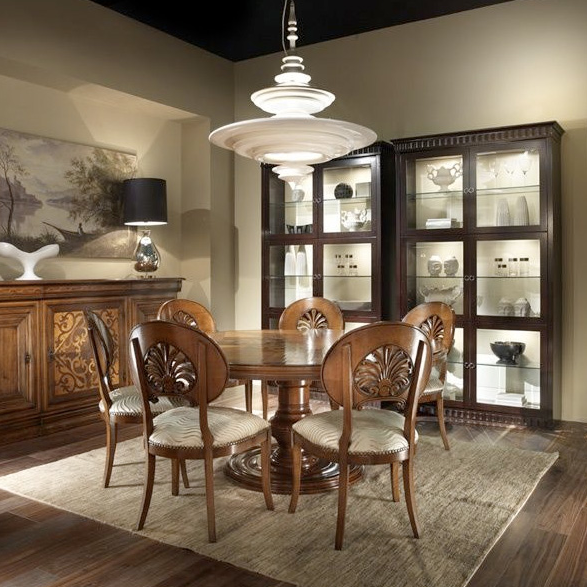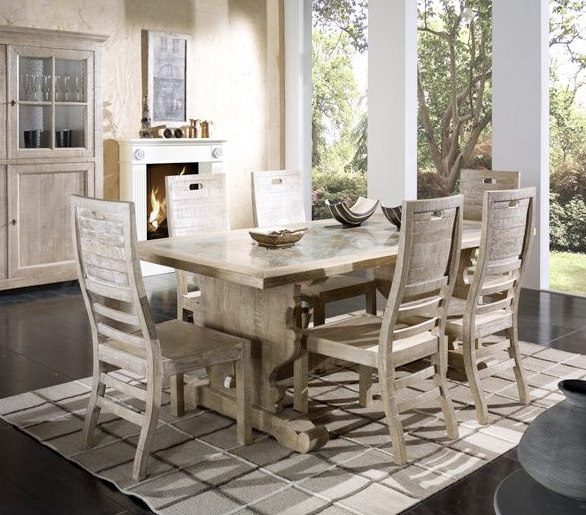Because they are special-occasion rooms, dining rooms should be very special.

“Dining rooms are places where families gather to share experiences and celebrations; they are rooms where memories are made,” says Davinder Chawla, IDS Associate and co-founder, with Alan K. Reinken, of La Maison Interiors. Opened Sept. 1, the full-service design studio and boutique features sophisticated furnishings and accessories at 15450 N. Scottsdale Road.
“We’re seeing that the dining room has reaffirmed its traditional purpose: as a place for formal dining and intimate entertaining events,” says Chawla, a native of India who oversees the La Maison team of 10 designers.
“One thing that has changed is the concept of the contemporary dining room, especially in relation to other rooms,” she explains, noting that home-owners now have great rooms, where much casual entertaining takes place.
Guests also viscerally move directly to the hearth, the kitchen, which typically includes a central entertaining and prep island. In addition, they can enjoy an adjacent breakfast nook with comfortable club chairs while socializing.
“I like the ‘fresh prep’ idea of an open kitchen/dining environment where food is being prepared and guests talk with the people who are cooking,” Chawla notes. “That’s another kind of an interaction that’s very valuable, talking with the cook. That spirit creates the feel of an open market, where people are feeding themselves while watching food being prepared.”
Much casual entertaining, then, is done in other rooms of the house rather than in the dining room. As a result, it retains the function of the great manorial halls of the past: It’s grand, inviting focal point tables and chairs, chandeliers, sculptural pieces and art work. Even if it’s not being used for a party, it remains vibrant even in its inactivity.

Still, Chawla does note that some people use the dining room based on a family-style service. In this approach, the food is on platters as the children enter the room. “This style of service allows the children to think about everyone seated around the table as they gauge a portion for themselves, to make sure the last person has a serving,” she says.
“I don’t think that the basic overall concept of the dining table and chair has changed very much in the past 3,000 years,” she adds. “At the same time, we’re finding that people are being more creative and eclectic — ‘transitional’ is another word we hear often — in how they are finishing this uniquely functioning room,” Chawla adds, explaining that people are requesting variety: richly patterned fabrics for the chairs, for example.
For instance, clients might have a contemporary colorful abstract in a traditional Southwestern dining room, which centers on a custom mesquite table and chairs. Or, they might choose an oval contemporary glass-topped table to match the curvatures of their walls and ceilings, which are faux painted in an Old World style.
La Maison Interiors can modify most dining room tables. If a client sees a rectangular table but would prefer that it be round, that the dimensions be slightly larger and that its edges be beveled, La Maison can arrange these changes.
Diversity and personal choice are trends. “Our clients will look at our dining room vignettes and will often pull a variety of ideas from them,” Chawla says. “From there, they think synergistically, combining ideas and styles for designs for a dining room that beautifully serves its special purpose.”
That’s what La Maison Interiors professionals offer. Chawla’s ability, for example, to mix patterns is in demand because of this stylistic trend in dining rooms and elsewhere in the home.
“My approach, and everyone’s at La Maison Interiors,” she says, “is to work with our clients to interpret their vision and ultimately create a functional, beautiful dining room that is their style — not anyone else’s.”
La Maison Interiors, www.lamaisonaz.com, 480.948.1144
